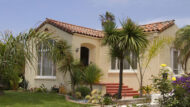Los Angeles is a city known for its glitz, glam, and entertainment industry, but beneath the surface, there’s a rich history and hidden details that many residents may not be aware of. From intriguing historical facts to lesser-known oddities, here are 10 interesting things about Los Angeles that might surprise you.
1. LA’s Underground Tunnels Were Once Used During Prohibition
Many residents don’t realize that a network of hidden underground tunnels lies beneath the bustling streets of downtown LA. These tunnels were used during Prohibition in the 1920s and early 1930s to transport liquor between speakeasies and safehouses without the prying eyes of law enforcement. Some of the entrances are still accessible today, allowing urban explorers a glimpse into this secret part of the city’s past.
During Prohibition, LA’s love for nightlife didn’t wane, and the tunnels served as a solution to keep the party going. These subterranean passageways were essential for bootleggers, smuggling illegal alcohol between bars and avoiding police raids. While the tunnels are no longer in use for this purpose, they serve as a reminder of the city’s rebellious and vibrant past.
2. Griffith Park Is Larger Than Central Park
Griffith Park, the vast expanse of green space in the heart of Los Angeles, is actually larger than New York’s iconic Central Park. Spanning over 4,200 acres, Griffith Park offers residents hiking trails, horseback riding, the LA Zoo, and the famous Griffith Observatory.
What makes Griffith Park stand out even more is its diversity of attractions. Whether you’re hiking up to the Hollywood sign, catching views of the city skyline, or visiting the museums within the park, Griffith has something for everyone. It’s a testament to LA’s connection with nature and the outdoors, offering a peaceful respite from the city’s busy streets.
3. Los Angeles Had the World’s Largest Trolley System
At the height of the early 20th century, Los Angeles boasted the world’s largest trolley system. The Pacific Electric Railway, often referred to as the “Red Car” system, covered hundreds of miles and connected downtown Los Angeles with outlying areas like Santa Monica, Long Beach, and Pasadena.
Unfortunately, the rise of the automobile and freeway culture led to the decline and eventual dismantling of the trolley system. Still, many Angelinos long for the days when the trolley was the primary mode of transportation, offering a glimpse of how the city might have developed differently had the system remained.
4. LA Is Home to Active Oil Rigs
When most people think of Los Angeles, oil rigs are likely not the first thing that comes to mind. However, scattered across the city are active oil fields and rigs that have been operating for decades. The LA Basin sits on one of the most oil-rich regions in the country, and despite the city’s urban sprawl, oil production continues to thrive in certain pockets.
What’s most surprising is that some of these oil rigs are cleverly disguised to blend in with their surroundings. For example, some are hidden behind walls or housed in plain-looking buildings, allowing the city to continue its oil production without being too conspicuous.
5. LA’s Natural Hot Springs Are a Hidden Gem
Los Angeles is not just about beaches and palm trees—it’s also home to natural hot springs. Located just outside the city, these springs offer a tranquil escape for those looking to relax in naturally warm, mineral-rich waters. These springs were once popular among indigenous tribes for their healing properties, and today, they provide a peaceful retreat for residents and tourists alike.
Though lesser-known, LA’s hot springs are an excellent way to unwind and enjoy nature, showcasing the diverse natural beauty that exists within and around the city.
6. Los Angeles Was Once Part of Mexico
Before becoming part of the United States in 1848, Los Angeles was a part of Mexico. The city’s Spanish and Mexican roots are still evident today in its architecture, street names, and the rich cultural diversity within LA’s neighborhoods.
LA’s history as a former Mexican territory is often celebrated through festivals, local cuisine, and historical landmarks. This unique heritage has made the city one of the most culturally diverse places in the world, with a strong Latino influence that is integral to its identity.
7. The Hollywood Sign Used to Read “Hollywoodland”
 The iconic Hollywood sign, synonymous with the film industry and LA’s celebrity culture, originally read “Hollywoodland” when it was erected in 1923. It was initially an advertisement for a real estate development in the Hollywood Hills. Over time, the “land” part was removed, leaving just “Hollywood.”
The iconic Hollywood sign, synonymous with the film industry and LA’s celebrity culture, originally read “Hollywoodland” when it was erected in 1923. It was initially an advertisement for a real estate development in the Hollywood Hills. Over time, the “land” part was removed, leaving just “Hollywood.”
The Hollywood sign has since become one of the most recognizable landmarks in the world. While it was once meant to promote a housing project, today it serves as a symbol of the world’s entertainment capital.
8. Los Angeles Hosts the Largest Historic Theater District in the U.S.
LA’s Broadway Theater District is home to the country’s largest concentration of historic movie palaces. Located in downtown Los Angeles, the district includes several beautifully restored theaters that once premiered some of Hollywood’s most famous films.
Though many theaters no longer function as movie houses, they are a reminder of the city’s golden age of cinema. Some venues still host events, concerts, and special screenings, providing a glimpse into the glamorous past of the movie industry.
9. LA Has the Largest Small-Boat Harbor in the World
Marina del Rey, located in Los Angeles, is the world’s largest man-made small-boat harbor. With over 4,600 boat slips, it’s a haven for recreational boating and water sports enthusiasts.
Marina del Rey is a popular spot for residents and tourists alike, offering access to dining, entertainment, and scenic boat tours. It’s one of the hidden treasures of the LA area, combining a laid-back coastal vibe with the energy of a major city.
10. LA Is Home to the Shortest Railroad in the World
Angels Flight, a funicular railway located in downtown Los Angeles, is known as the shortest railroad in the world. This historic railway, just 298 feet long, originally opened in 1901 and transported people up and down the steep Bunker Hill.
Today, Angels Flight is both a tourist attraction and a piece of LA’s history, offering a charming and unique way to explore the city. While it may be short, its significance to LA’s heritage is monumental.
Los Angeles is a city full of surprises, with a history and culture that go far beyond Hollywood. From underground tunnels and oil rigs to the world’s shortest railroad and hidden hot springs, there’s always something new to discover in this diverse metropolis. Whether you’re a longtime resident or just visiting, these little-known facts about LA highlight the unique aspects of a city that never ceases to amaze.







